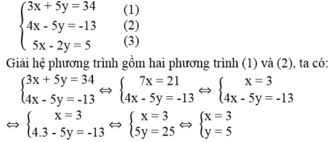Giaỉ phương trình sau ;
x-3/x-2 - x-2/x-4 = 1 và 5/21
1 và 5/21 là hỗn số nha do mik ko vt dc nên ms vt vậy =(((
Hãy nhập câu hỏi của bạn vào đây, nếu là tài khoản VIP, bạn sẽ được ưu tiên trả lời.

Bài 1:
a) Ta có: \(2\left(3-4x\right)=10-\left(2x-5\right)\)
\(\Leftrightarrow6-8x-10+2x-5=0\)
\(\Leftrightarrow-6x+11=0\)
\(\Leftrightarrow-6x=-11\)
hay \(x=\dfrac{11}{6}\)
b) Ta có: \(3\left(2-4x\right)=11-\left(3x-1\right)\)
\(\Leftrightarrow6-12x-11+3x-1=0\)
\(\Leftrightarrow-9x-6=0\)
\(\Leftrightarrow-9x=6\)
hay \(x=-\dfrac{2}{3}\)

\(b,ĐK:-\dfrac{1}{3}\le x\le2\\ PT\Leftrightarrow3x+1=4x^2-16x+16\\ \Leftrightarrow4x^2-19x+15=0\\ \Leftrightarrow\left[{}\begin{matrix}x=\dfrac{15}{4}\left(ktm\right)\\x=1\left(tm\right)\end{matrix}\right.\Leftrightarrow x=1\\ d,\Leftrightarrow\left\{{}\begin{matrix}x=5-3y\left(1\right)\\\left(5-3y\right)^2+2y^2=25\left(2\right)\end{matrix}\right.\\ \left(2\right)\Leftrightarrow11y^2-30y=0\\ \Leftrightarrow y\left(11y-30\right)=0\Leftrightarrow\left[{}\begin{matrix}y=0\Rightarrow x=5-3\cdot0=5\\y=\dfrac{30}{11}\Rightarrow y=5-3\cdot\dfrac{30}{11}=-\dfrac{35}{11}\end{matrix}\right.\)
Vậy \(\left(x;y\right)\in\left\{\left(5;0\right);\left(-\dfrac{35}{11};\dfrac{30}{11}\right)\right\}\)

a: Khi m=2 thì pt sẽ là x^2-6x-3=0
=>\(x=3\pm2\sqrt{3}\)


Thay x = 3, y = 5 vào vế trái của phương trình (3) ta được:
VT = 5.3 – 2.5 = 15 – 10 = 5 = VP
Vậy (x; y) = (3; 5) là nghiệm của phương trình (3).
Hệ phương trình đã cho có nghiệm (x; ) = (3; 5)
Ta có: \(\dfrac{x-3}{x-2}-\dfrac{x-2}{x-4}=1\dfrac{5}{21}\)
\(\Leftrightarrow\dfrac{21\left(x-3\right)\left(x-4\right)}{21\left(x-2\right)\left(x-4\right)}-\dfrac{21\left(x-2\right)^2}{21\left(x-2\right)\left(x-4\right)}=\dfrac{26\left(x-2\right)\left(x-4\right)}{21\left(x-2\right)\left(x-4\right)}\)
\(\Leftrightarrow26\left(x^2-6x+8\right)=21\left(x^2-7x+12\right)-21\left(x^2-4x+4\right)\)
\(\Leftrightarrow26x^2-156x+208=21x^2-147x+252-21x^2+84x-84\)
\(\Leftrightarrow26x^2-156x+208+63x-168=0\)
\(\Leftrightarrow26x^2-93x+40=0\)
\(\text{Δ}=\left(-93\right)^2-4\cdot26\cdot40\)
\(=8649-4160\)
\(=4489\)
Vì Δ>0 nên phương trình có hai nghiệm phân biệt là:
\(\left\{{}\begin{matrix}x_1=\dfrac{93-67}{52}=\dfrac{1}{2}\left(nhận\right)\\x_2=\dfrac{93+67}{52}=\dfrac{40}{13}\left(nhận\right)\end{matrix}\right.\)